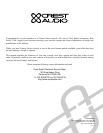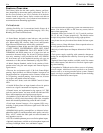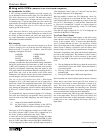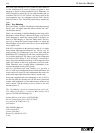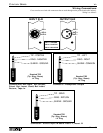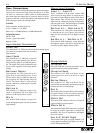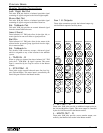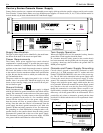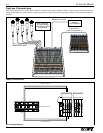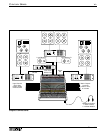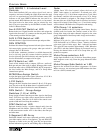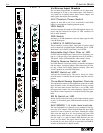
An introduction to VCA's
A VCA (voltage controlled amplifier) uses a DC control volt-
age to attenuate or boost an audio signal. The VCA DOES NOT
have Audio signal present in the fader. The fader only controls
the amount of voltage (level) an input can have to a mix buss
or summing amp. To get the input back out of the console, the
input needs to be assigned to the Stereo Mix Buss or an Audio
Group. Assigning a fader only to a VCA will not allow an
input to get out of the console.
Audio Submasters DO have audio signal present in the fader.
All inputs assigned to an Audio Submaster are summed, and
are useful as line-level returns and sends, and group process-
ing. Audio Submasters are especially useful as effects returns
when inputs have been exhausted.
Mix Integrity
VCA’s are useful when a mix must be brought up or down
without changing the relationship between Subgroups.
Depicted below is a typical mix in Mono, with the Audio
Subgroups configured as follows:
1-DRUMS 2-PERCUSSION
3-GUITAR 4-BASS
5-KEYS 6-EFFECTS
7-BACKRND VOCALS 8-LEAD VOCAL
Although a suitable mix has been obtained during soundcheck,
during the performance the band turns up their level about
+10db, and everything will need to be turned down quickly.
Typically, the engineer would bring down the master or grab
all 8 group faders with both hands and pull everything down. A
quick listen, and a look at the relative levels of the Audio
Submasters will indicate that the mix has been compromised,
and the integrity of the mix will need to be restored.
This all can be easily handled with VCA’s. With inputs
assigned to VCA’s, the entire band mix can be turned up or
down with 1 fader. The relationship between the VCA Groups
(the ‘mix’ or the ‘blend’) will remain the same, without physi-
cally moving the Subgroups, and will remain exactly the same
at all levels. All that is needed is to move a “Band Master”
VCA.
To accomplish this, inputs would be assigned to VCA Groups.
The same basic Subgroup assignments shown previously
would be used in the Audio Subgroups, but with 2 major dif-
ferences:
A) Group #8 is labeled BAND MASTER;
B) the Lead Vocal is assigned directly to the LEFT &
RIGHT MASTERS, and is not assigned to a Group.
The levels of all VCA Subgroups would be set at “0dB” (nom-
inal). This is because “0dB” is where VCA’s operate best. It is
the “Unity” position. (Indicated by the "Unity" LED).
A stereo mix can be obtained immediately, because the inputs
can be assigned directly to the STEREO MASTER. In addi-
tion, all “band” input faders must be DOUBLE ASSIGNED to
2 VCA Subgroups. In other words, all Band inputs assigned to
VCA Subgroups 1 thru 5, (not 6 or 7, and you’ll see why later)
also need be assigned to VCA Subgroup 8.
What this enables is control over VCA Subgroups 1 thru 5 by
using VCA Subgroup 8 as the Band Master. Once set, the
entire blend (band mix) can be brought up or down by moving
only VCA 8. “Mix Integrity” is now possible. Some term this
as ‘poor man’s automation’, because any input assigned to
VCA subgroup 8 will electronically “move” as if the faders
had been physically moved.
Note that any inputs assigned to two (2) VCA Subgroups are
controlled by BOTH VCA Subgroups.
True Post Effect Sends
This section will examine what happens to the effect (Aux)
sends when the Audio Subgroups are used as in the example
above. In this example, Aux 1 is used for the Main Reverb,
Aux 2 for Drum Reverb and Aux 3 for the Delay. A Drum
Solo will be employed for the example here. The effects are in
Audio Group 6, making it possible to pull the effects down
between songs, or if the wet / dry balance needs to changed.
The band is cooperating at this point and the Audio Submasters
are back to the starting point. The drummer is about to take a
big solo for the night, and it will be necessary to turn Audio
Subgroup 1 up 10dB. At this point, one of two things must be
done:
1) Turn up Subgroup #6 10db also to keep the reverb at the
same relation it was to the “DRY” drum sound before it
was turned up; OR
2) Turn up all Aux sends on the drum inputs 10dB (not
desirable); OR
3) Turn up all Drum inputs 10dB on the input faders.
The reason that one of these options must be chosen is because
effects busses (aux busses) do not and will never increase or
decrease in level when an Audio Submaster is turned up or
down. This alone is the most critical aspect of why Audio
Submasters are not acceptable for controlling a mix. What has
been described here is a drum solo situation; imagine the prob-
lems encountered when adding the other Submasters!
A common solution used when using Audio Submasters is to
mix on the input faders. This way all effects will “follow” the
moves made on the faders in direct proportion. Although it is a
painful way to mix, some engineers will always mix on the
input faders.
(continued on page 8)
VX
PAGE 3
CENTURY SERIES
Mixing with VCA's (adapted from Live Sound! magazine)




